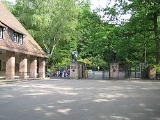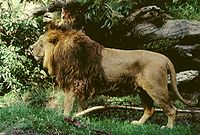
Tiergarten Nürnberg
Encyclopedia
Nuremberg Zoo is a zoo located in the Nuremberg Reichswald
("imperial forest"), southeast of Nuremberg
, Germany. With an area of 0.67 square kilometres (165.6 acre), approximately 300 animal species are kept by the zoo.
at the Dutzendteich and was closed in February 1939. In May 1939, the new zoo was opened in the Reichswald at the Schmausenbuck. It was almost completely destroyed after World War II and rebuilt at the end of the 1950s.
 With 0.67 square kilometres (165.6 acre), it is one of the largest European zoos. Typical are large, natural enclosures, which are embedded in a landscape of forests and stone pits. More than one million visitors are counted every year. Many new enclosures, e.g., for gorillas, snow leopards and polar bears, were built in recent years.
With 0.67 square kilometres (165.6 acre), it is one of the largest European zoos. Typical are large, natural enclosures, which are embedded in a landscape of forests and stone pits. More than one million visitors are counted every year. Many new enclosures, e.g., for gorillas, snow leopards and polar bears, were built in recent years.
Flocke
, a captive-born polar bear who was born at the zoo in December 2007, became a popular tourist attraction and an international celebrity after a controversial decision to remove her from her mother and raise her by hand. Flocke has since been "adopted" by United Nations Environment Programme
chief Achim Steiner
.
s and Siberian tigers, which live in former stone pits. The inner cages of both large cat species are behind a rock face and can be visited only after entering the house through a tunnel. Other carnivores are snow leopard
s, polar bear
s, Syrian brown bears, and maned wolves. The zoo is also successful in breeding cheetah
s.
Further attractions are Common bottlenose dolphin
s, Indian rhinoceros
es, Malayan tapir
s, lowland gorillas, California sea lion
s and manati
s.
Many hooved mammals, like reticulated giraffes, Somali wild asses, Père David's deer
, European and American bison, African buffalo, plains zebras and kulan
s live in large enclosures, which are embedded in the forested, hilly landscape. Beautiful ponds are home to a variety of water birds.
Reichswald
A Reichswald designates a historic woodland under imperial protection and usage in the lands of the former Holy Roman Empire. It may refer to:* Nürnberger Reichswald — an old cultivated forest with near Nuremberg, which is today a nature reserve....
("imperial forest"), southeast of Nuremberg
Nuremberg
Nuremberg[p] is a city in the German state of Bavaria, in the administrative region of Middle Franconia. Situated on the Pegnitz river and the Rhine–Main–Danube Canal, it is located about north of Munich and is Franconia's largest city. The population is 505,664...
, Germany. With an area of 0.67 square kilometres (165.6 acre), approximately 300 animal species are kept by the zoo.
In the Middle Ages
The tradition of zoos in Nuremberg goes back to the Middle Ages. However the only indications of a zoo maintained by the local nobility, the Burgraves, take the form of certain place names, such as the Zoo Gate (Tiergärtner Tor) and the adjoining Zoo Square (Tiergärtnertorplatz). This preserve stretched as far as the so called Johannisfelder (today: St. Johannis) and the Rohlederersgarten (today the site of the Klinikum Nord). One can only speculate about the use made of the park.20th century
The Nuremberg Zoo was founded on 11 May 1912 on the site of the Bavarian State Exhibition at the Luitpoldhain. After the Nazis seized power, the zoo had to give way for the ReichsparteitagsgeländeNazi party rally grounds
The Nazi party rally grounds consist of about 11 square kilometres in the southeast of Nuremberg, Germany...
at the Dutzendteich and was closed in February 1939. In May 1939, the new zoo was opened in the Reichswald at the Schmausenbuck. It was almost completely destroyed after World War II and rebuilt at the end of the 1950s.
Today

Flocke
Flocke
Flocke is a female polar bear who was born in captivity at the Nuremberg Zoo in Nuremberg, Germany on 11 December 2007. A few weeks after her birth, she was removed from her mother's care after concerns were raised for her safety. Although the zoo had established a strict non-interference policy...
, a captive-born polar bear who was born at the zoo in December 2007, became a popular tourist attraction and an international celebrity after a controversial decision to remove her from her mother and raise her by hand. Flocke has since been "adopted" by United Nations Environment Programme
United Nations Environment Programme
The United Nations Environment Programme coordinates United Nations environmental activities, assisting developing countries in implementing environmentally sound policies and practices. It was founded as a result of the United Nations Conference on the Human Environment in June 1972 and has its...
chief Achim Steiner
Achim Steiner
Achim Steiner is a German expert in environmental politics. From 2001 to 2006 he was Director General of the International Union for Conservation of Nature and Natural Resources...
.
Animals
The zoo has Asiatic lionAsiatic Lion
The Asiatic lion also known as the Indian lion, Persian lion and Eurasian Lion is a subspecies of lion. The only place in the wild where the lion is found is in the Gir Forest of Gujarat, India...
s and Siberian tigers, which live in former stone pits. The inner cages of both large cat species are behind a rock face and can be visited only after entering the house through a tunnel. Other carnivores are snow leopard
Snow Leopard
The snow leopard is a moderately large cat native to the mountain ranges of South Asia and Central Asia...
s, polar bear
Polar Bear
The polar bear is a bear native largely within the Arctic Circle encompassing the Arctic Ocean, its surrounding seas and surrounding land masses. It is the world's largest land carnivore and also the largest bear, together with the omnivorous Kodiak Bear, which is approximately the same size...
s, Syrian brown bears, and maned wolves. The zoo is also successful in breeding cheetah
Cheetah
The cheetah is a large-sized feline inhabiting most of Africa and parts of the Middle East. The cheetah is the only extant member of the genus Acinonyx, most notable for modifications in the species' paws...
s.
Further attractions are Common bottlenose dolphin
Common Bottlenose Dolphin
Tursiops truncatus, commonly known as the Common Bottlenose Dolphin, is the most well-known species from the family Delphinidae.Common bottlenose dolphins are the most familiar dolphins due to the wide exposure they receive in captivity in marine parks, dolphinarias, in movies, and television...
s, Indian rhinoceros
Indian Rhinoceros
The Indian Rhinoceros is also called Greater One-horned Rhinoceros and Asian One-horned Rhinoceros and belongs to the Rhinocerotidae family...
es, Malayan tapir
Malayan Tapir
The Malayan Tapir , also called the Asian Tapir, is the largest of the four species of tapir and the only one native to Asia. The scientific name refers to the East Indies, the species' natural habitat...
s, lowland gorillas, California sea lion
California Sea Lion
The California sea lion is a coastal sea lion of western North America. Their numbers are abundant , and the population continues to expand about 5% annually. They are quite intelligent and can adapt to man-made environments...
s and manati
Manatí
Manatí may refer to:*Manatí, Puerto Rico*Manatí, Atlántico in Atlantico, Colombia*Manatí, Cuba, a municipality in Las Tunas, CubaManatí is also the Spanish word for manatee.*See also: Special:Allpages/Manatí...
s.
Many hooved mammals, like reticulated giraffes, Somali wild asses, Père David's deer
Père David's Deer
Père David's Deer, Elaphurus davidianus, also known as the Milu , is a species of deer known only in captivity. It prefers marshland, and is believed to be native to the subtropics of China. It grazes on a mixture of grass and water plants. It is the only extant member of the genus Elaphurus...
, European and American bison, African buffalo, plains zebras and kulan
Kulan
Khulan was an empress of Genghis Khan and head of the second Court of Genghis Khan. Her status in the Mongol Empire was second only to Grand Empress Borte.-Biography:...
s live in large enclosures, which are embedded in the forested, hilly landscape. Beautiful ponds are home to a variety of water birds.
Literature
- Dr. Peter Mühling, Der Alte Nürnberger Tiergarten 1912–1939: Eine Chronik, Tiergarten der Stadt Nürnberg, Nürnberg 1987, ISBN 3-926760-00-1
- Wegweiser durch den Tiergarten Nürnberg, 29. neubearbeitete Auflage, Tiergarten der Stadt Nürnberg, Nürnberg 2007, ISSN 1436-4352
- Lorenzo von Fersen, Delfinariumsführer Tiergarten Nürnberg, 3. Aufl., Tiergarten der Stadt Nürnberg, Nürnberg 2003, ISBN 3-926760-04-4
- Der Tiergarten Nürnberg – Ein Virtueller Rundgang, imbiss-media, Nürnberg 2002, ISBN 3-00-010598-0
- Michael Diefenbacher, Rudolf Endres (Hsg.): Stadtlexikon Nürnberg. 2. verb. Auflage. Nürnberg: Verlag W. Tümmels, 2000, 1247 S., ISBN 3-921590-69-8

